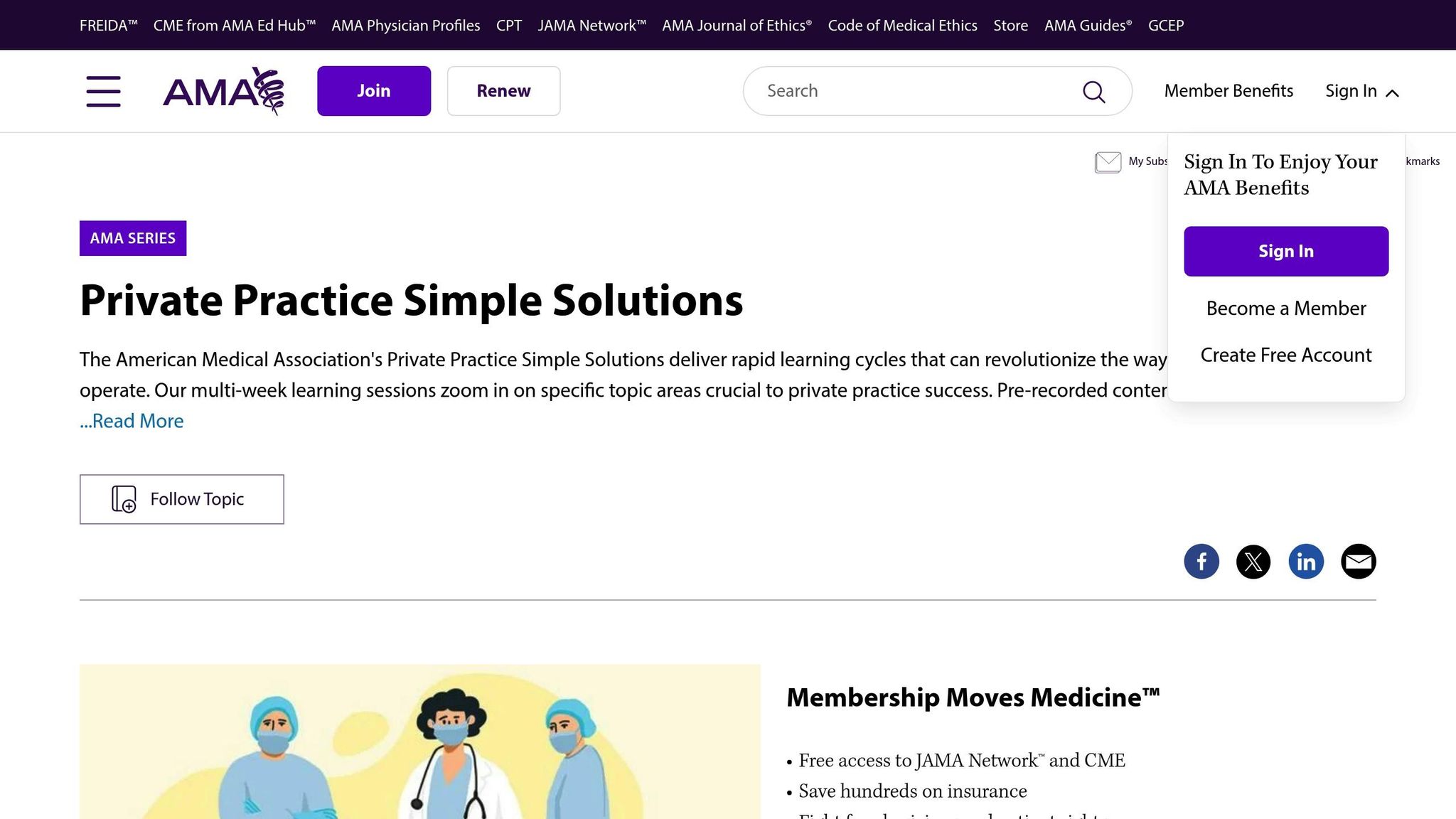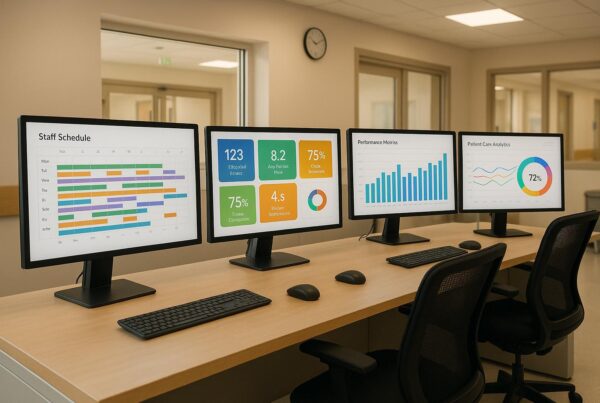Virtual assistants are increasingly used in healthcare to handle patient calls, but improper training can lead to serious issues like compliance violations, data breaches, and poor patient experiences. Effective training ensures assistants communicate clearly, maintain empathy, and follow strict security protocols. Here’s what matters most:
- Patient Communication: Teach tone, clarity, active listening, and respect for diverse backgrounds.
- HIPAA Compliance: Ensure assistants understand privacy rules, security measures, and breach protocols.
- EMR Systems: Train on navigating and documenting within electronic medical records.
- Emergency Handling: Prepare assistants for urgent and sensitive situations through role-playing and feedback.
A structured process – starting with orientation, supervised practice, and continuous education – helps virtual assistants perform confidently and securely. Tailoring training to your practice’s needs, like dental or veterinary care, further improves outcomes. Regular feedback and performance reviews refine skills over time, ensuring assistants meet both patient and practice expectations.
Private Practice Simple Solutions Virtual Assistants

Core Principles of Patient Communication
Effective communication with patients is a cornerstone of quality healthcare. Virtual assistants need to do more than just follow basic etiquette – they must establish meaningful connections while maintaining professional boundaries. These core principles lay the groundwork for the specific training elements discussed in later sections.
Tone, Clarity, and Empathy
Using a calm and clear tone is essential when discussing health matters, as it helps build trust. Virtual medical assistants should rely on tailored scripts and responses designed to replicate empathetic conversations. Training programs should teach them to recognize subtle cues, such as tone and word choice, so they can adjust their responses accordingly [1]. For example, detecting anxiety in a patient’s voice about an upcoming procedure allows the assistant to respond with reassurance and a composed sense of urgency.
Advanced tools like natural language processing enable virtual assistants to handle sensitive situations with care. Whether addressing complaints or delivering difficult news, these assistants can use language that acknowledges a patient’s emotions while still providing necessary information [1]. Empathy is at the heart of these interactions, helping to build trust, improve communication, and make patients feel valued and understood [1]. Developing these skills is a key step in training virtual assistants for effective patient communication.
Sensitivity and Respect for All Patients
Today’s healthcare providers serve diverse populations, making cultural awareness a crucial skill for virtual assistants. Cultural sensitivity involves understanding how a patient’s background influences their values, beliefs, and attitudes. It also means respecting individual differences [7].
"Cultural competency in healthcare is important because it directly influences the quality, efficacy, and accessibility of care provided to patients from a wide range of backgrounds." – Quality Interactions [6]
Misunderstandings rooted in cultural differences can lead to errors, such as misdiagnoses or inappropriate treatments [6]. To prevent this, virtual assistants should avoid assumptions based on names, accents, or communication styles. Training should include asking respectful questions about patients’ and families’ values and practices, as well as understanding their psychological, social, and cultural needs. This might involve learning about secondary languages, non-verbal communication methods, religious practices, or dietary preferences [7].
For example, some patients may prefer a same-gender healthcare provider, while others may require extra time to process medical information due to language barriers. Incorporating this type of training ensures every patient interaction is handled with respect and care. Active listening and cultural awareness go hand in hand to create a supportive and inclusive environment.
Active Listening Skills
Active listening transforms routine conversations into meaningful exchanges by focusing entirely on the patient’s words, ensuring their concerns are understood and addressed [5]. Virtual assistants should practice careful listening, ask clarifying questions, and summarize what they hear to confirm understanding [2] [4]. For instance, if a patient describes their symptoms, the assistant might respond, “It sounds like you’ve been experiencing sharp lower back pain for three days, which worsens when you sit. Is that correct?”
Even during phone calls, paying attention to vocal cues can reveal a patient’s emotional state or level of concern. Training should emphasize avoiding interruptions and giving patients the time they need to fully express themselves. This approach not only helps clarify patient needs but also ensures accurate communication about appointments, procedures, and policies across various platforms [3]. Whether managing routine inquiries or urgent situations, active listening is a vital skill for virtual medical assistants to master.
Key Training Components for Virtual Assistants
After mastering communication basics, the focus shifts to specialized training that ensures virtual assistants can handle patient calls with precision, empathy, and security. These modules are designed to support high-quality patient care while maintaining efficiency. Training for virtual assistants revolves around three key areas to ensure safe and effective patient interactions.
HIPAA Compliance and Data Security
For virtual medical assistants, HIPAA compliance is a non-negotiable requirement. With 60% of U.S. healthcare offices relying on virtual assistants, proper training in HIPAA protocols is not just necessary; it also offers significant cost savings – potentially reducing staffing expenses by up to 70% [8].
Training must thoroughly address the three main HIPAA rules: the Privacy Rule, Security Rule, and Breach Notification Rule [8]. Virtual assistants need to know how to safeguard Protected Health Information (PHI), recognize security threats, and respond effectively to potential breaches. This includes practical measures like avoiding phishing attempts, setting strong passwords, and securely handling patient data during calls [8].
Take Virtual Nurse Rx, for instance. They enforce HIPAA protocols through mandatory courses, annual exams, and real-time monitoring. If a breach occurs, their system immediately halts communication with the compromised device [9].
Access controls and role-based permissions are equally critical, ensuring that virtual assistants only access the information necessary for their role. Regular security risk assessments and compliance audits further strengthen data protection efforts.
"Regular training and policy reviews keep virtual assistants up to date and following rules" [8].
Once data security is addressed, the next focus is on mastering EMR systems and call scripts.
EMR Systems and Call Scripts
Navigating Electronic Medical Record (EMR) systems is a core skill for virtual assistants managing patient interactions. Training should cover secure login practices, customizing dashboards, retrieving reports, documenting notes, and communicating with patients through the system [11]. A structured 30-60-90 day training plan with clear benchmarks can help virtual assistants gain confidence and competence in these areas.
Using conversational AI for simulation training is an effective way to reinforce these skills. This technology replicates real patient calls, offering mid-call feedback and performance scores [10]. Training modules should include tasks like patient intake, appointment scheduling, insurance verification, troubleshooting portal issues, empathy-driven scripting, and escalation protocols [10].
A team member from Practolytics highlighted the importance of structured training, noting that virtual assistants often feel overwhelmed without clear guidance on EMR navigation [11].
Successful training strategies might include:
- Microlearning sessions with short videos and quizzes targeting specific tasks.
- Real-world role-playing exercises that introduce unexpected scenarios.
- Weekly shadowing opportunities with team members to observe workflows.
Continuous improvement is supported by real-life call feedback and performance reviews after initial training. Companies like GoLean incorporate comprehensive EMR training into their HIPAA-compliant services, enabling healthcare providers to integrate virtual assistants seamlessly into their operations.
Once virtual assistants are proficient with EMR systems, the next step is equipping them to handle emergencies and challenging situations effectively.
Handling Emergencies and Difficult Situations
Dealing with emergencies requires advanced training beyond standard communication skills. Role-playing exercises are invaluable for preparing virtual assistants to respond to a variety of emotional states and patient concerns in a controlled environment [13].
Those working with mental health practices need specialized training to understand mental health conditions, treatments, and crisis intervention strategies [12]. They must also handle sensitive patient information with care and maintain professional boundaries [12]. Training should prepare virtual assistants to communicate effectively across multiple platforms, including email, phone, and telemedicine, ensuring they can address patient concerns and relay critical information with professionalism.
Regular performance evaluations are a key part of emergency training, helping to identify strengths and areas for improvement in high-pressure situations [13]. Virtual assistants must also learn when to escalate calls to licensed medical professionals and how to maintain calm, supportive communication during emergencies.
Incorporating diverse, realistic scenarios into training helps build problem-solving skills and prepares virtual assistants for unexpected challenges [10]. The ultimate goal is to ensure they consistently deliver clear, professional communication while offering compassionate support to patients in distress [12].
sbb-itb-109dad4
Step-by-Step Training Process for Virtual Assistants
A well-organized training process helps new virtual assistants gain the skills they need to handle patient calls independently. This requires careful planning, steady support, and continuous learning to maintain high standards of patient care.
Orientation and Practice
Start with a thorough onboarding program that introduces staff to their roles, emphasizes compliance, and sets clear expectations [15]. Providing detailed job descriptions and outlining specific tasks helps eliminate confusion and boosts productivity from day one. Pre-boarding tools like welcome packets, login credentials, and initial materials can also ease first-day nerves [14].
Interactive HIPAA and security training, featuring real-world scenarios and role-playing, reinforces key compliance concepts. Clear standard operating procedures (SOPs), checklists, and detailed guides covering software use, task workflows, and practice-specific policies ensure ongoing support. Shadowing experienced team members during the initial phase allows new hires to gradually build their skills [26, 27].
Once this foundation is in place, supervised practice ensures these skills are refined under close guidance.
Supervised Practice and Feedback
Supervised practice is a crucial step for building confidence and fine-tuning skills after orientation. Clearly define roles, set SMART goals, and communicate the practice’s core values [16]. Leverage digital tools to provide real-time feedback and track progress [16]. Regular check-ins through meetings or video calls help maintain a strong connection and provide support, especially for remote teams [14].
For instance, Green Mountain Partners for Health successfully applied this approach when hiring virtual assistants to handle tasks like managing faxes, billing, scheduling, and messaging. Dr. Carolynn Francavilla, the clinic’s CEO, reported that this method improved staff satisfaction and enhanced patient access [8].
This structured feedback process naturally transitions into ongoing education and regular performance reviews.
Continued Education and Performance Reviews
Once virtual assistants begin working independently, continuous development becomes essential. Schedule performance reviews at regular intervals – 30, 60, and 90 days initially, followed by quarterly reviews – to assess progress and address areas needing improvement [17]. Offer training resources, webinars, and certifications to keep virtual assistants up to date with changing healthcare regulations and best practices [17].
Monitor key performance indicators (KPIs) such as call duration, first-call resolution rates, and patient satisfaction to guide improvements [17]. Role-playing exercises and reviewing recorded calls can further enhance communication skills. For example, a study conducted at Lillebaelt Hospital in Denmark found that a three-day training program based on the Calgary-Cambridge Guide significantly improved patient-centered communication [18].
GoLean’s training model follows a similar structure, ensuring virtual assistants are fully prepared to meet the specific needs of each practice effectively.
Customizing Training for Your Practice
Every healthcare specialty comes with its own set of challenges, patient expectations, and operational workflows. For instance, the way a dental office functions is vastly different from a veterinary clinic, just as an optometry practice operates differently from a chiropractic center. By building on foundational communication skills and structured training, practices can fine-tune their processes to match their unique needs.
Training for Different Practice Specialties
Healthcare practices aren’t one-size-fits-all. Each specialty requires specific approaches to patient communication and administrative tasks, layered on top of core skills like active listening and empathy.
- Dental Practices: These offices often deal with patients who are anxious about procedures. Training should focus on calming techniques, explaining treatments like root canals or extractions in simple terms, and navigating insurance pre-authorizations. Assistants must also be familiar with dental terminology and ways to make patients feel at ease.
- Veterinary Clinics: Here, the communication challenge lies in speaking with pet owners rather than the patients themselves. Assistants should understand animal behavior terms, emergency triage protocols, and how to gather detailed symptom information. Special attention is needed for emotionally charged situations, like discussing end-of-life care or handling emergencies.
- Optometry and Chiropractic Practices: These fields require an understanding of their specific tools and processes. In optometry, assistants should know how to handle vision insurance, order contact lenses, and provide pre-exam instructions. Chiropractic practices, with their ongoing treatment plans, benefit from assistants who can explain scheduling patterns and treatment frequencies.
Creating Practice-Specific Scripts and Templates
Scripts are crucial for maintaining consistency while reflecting your practice’s unique voice. In healthcare, where conversations can be sensitive, scripts should prioritize empathy and understanding. For example, a dental assistant might reassure a nervous patient by saying, "We understand dental visits can feel overwhelming, but we’re here to make the process as comfortable as possible."
Scripts should also highlight your practice’s strengths – like offering flexible appointment times or streamlined insurance handling. Including responses to common patient concerns can help keep conversations productive. For example, if a patient hesitates about scheduling, a script might gently steer them back by emphasizing the benefits of timely care.
Instead of creating one lengthy, catch-all document, consider breaking scripts into smaller, focused sections. For example:
- Patient identification and basic information gathering
- Appointment scheduling and insurance verification
- Follow-up instructions or post-treatment care
This modular approach makes it easier to adapt scripts for different scenarios while keeping interactions natural and conversational.
Using Feedback to Improve Training
Effective training isn’t a one-and-done process – it evolves through regular feedback. Input from both patients and staff can pinpoint areas for improvement and ensure virtual assistants are meeting expectations.
- Patient Feedback: Patients can shed light on whether assistants are using the right tone, addressing concerns adequately, and providing clear information. For instance, if patients frequently report confusion about appointment prep instructions, it may signal a need for clearer communication or updated scripts.
- Staff Feedback: Insights from physicians, nurses, and office managers can reveal operational challenges, such as inefficiencies with scheduling software or misunderstandings about practice policies. These insights can guide targeted training updates.
Feedback can be gathered through surveys, team meetings, and call monitoring. Analytics can also highlight trends – like repeated issues with a specific process – prompting adjustments to training programs. For example, one UK hospital used patient feedback to revamp its scheduling system, introducing online booking to cut wait times and improve satisfaction.
Regular feedback loops, where assistants review challenging calls and share successes, are invaluable. These sessions not only help refine skills but also ensure assistants stay aligned with evolving patient needs and industry practices. Continuous updates to training based on this feedback keep virtual assistants well-prepared to support your practice effectively.
Conclusion: Key Takeaways for Virtual Assistant Training
Training virtual assistants is a critical step in strengthening your practice while improving patient care. Consider this: nearly 60% of healthcare offices in the U.S. now use virtual assistants to streamline operations, with some practices cutting staff expenses by up to 70% [8]. These numbers highlight the growing role of virtual assistants in modern healthcare.
A well-rounded training program should include HIPAA compliance, EMR system proficiency, and emergency protocol awareness to ensure top-notch patient care. As data security challenges persist, compliance training remains a must for healthcare providers. These elements underscore the importance of tailored training programs that address the specific needs of your practice.
Focusing on communication skills and customizing training to suit your practice can significantly boost assistant performance. For example, a dental office managing nervous patients or a veterinary clinic addressing concerned pet owners will benefit from programs designed to meet their unique challenges. Health IT expert Sharmeen Saleem emphasizes this point:
"Regular training and policy reviews keep virtual assistants up to date and following rules." [8]
Real-world examples reveal how virtual assistant training improves staff satisfaction and expands patient access [8]. Practices report benefits like fewer no-shows and more efficient documentation processes, proving the value of investing in training.
Ongoing education and consistent feedback are key to long-term success. When done right, virtual assistant training evolves from a one-time cost to a strategic investment that drives better patient experiences, lowers compliance risks, and increases efficiency. In today’s fast-paced healthcare environment, committing to continuous training is more than an operational decision – it’s a competitive edge.
For practices looking to stay ahead, starting with comprehensive training is essential. At GoLean (https://golean.health), we embed these principles into our programs, ensuring that our virtual assistants are not only HIPAA-trained and EMR-proficient but also equipped to provide compassionate and accurate patient interactions. In a healthcare world that values patient-centered care, well-trained virtual assistants are no longer optional – they’re indispensable.
FAQs
What mistakes should I avoid when training virtual assistants to handle patient calls in healthcare?
When preparing virtual assistants to handle patient calls, there are a few key missteps you’ll want to sidestep:
- Ignoring HIPAA training: Skipping over HIPAA regulations can lead to serious data privacy violations – and the legal headaches that come with them. Assistants must fully understand how to handle sensitive patient information securely.
- Rushing or limiting training: Without proper guidance on communication skills, confidentiality, and maintaining a professional tone, patient trust can erode quickly. Thorough preparation is non-negotiable for quality interactions.
- Neglecting ongoing support: Training shouldn’t stop after onboarding. Regular refresher sessions and performance evaluations are crucial to keep standards high and ensure assistants stay aligned with current best practices.
By focusing on these areas, you’ll help your virtual assistants deliver better patient interactions and build trust while safeguarding sensitive information.
How can healthcare practices keep their virtual assistants up-to-date with compliance and communication standards?
To keep virtual assistants aligned with compliance and communication standards, healthcare practices should prioritize regular training sessions focused on HIPAA regulations, data security measures, and best practices for patient interactions. Consistent education ensures they meet legal requirements while effectively engaging with patients.
Beyond training, healthcare providers should perform regular risk assessments, adopt secure communication tools, and stay updated on regulatory changes, including potential updates to HIPAA guidelines. These measures not only safeguard sensitive patient data but also enhance the quality of service virtual assistants deliver.
How can virtual assistants be trained to meet the unique needs of different healthcare specialties like dental or veterinary practices?
Training virtual assistants for specialized healthcare fields means shaping their skills to align with the specific needs and language of each practice. For dental offices, this means focusing on tasks like scheduling appointments, verifying insurance details, and communicating with patients clearly and efficiently. Precision is key here, as even small errors can impact patient care and satisfaction.
In veterinary clinics, the emphasis shifts toward handling client questions, showing empathy in communication, and becoming familiar with veterinary terminology. Compassion plays a big role, especially when interacting with pet owners during stressful situations.
To ensure virtual assistants are ready for these roles, use real-world scenarios and conduct regular evaluations. This method ensures they’re equipped to handle the unique demands of each specialty while maintaining a professional and empathetic approach to their work.



